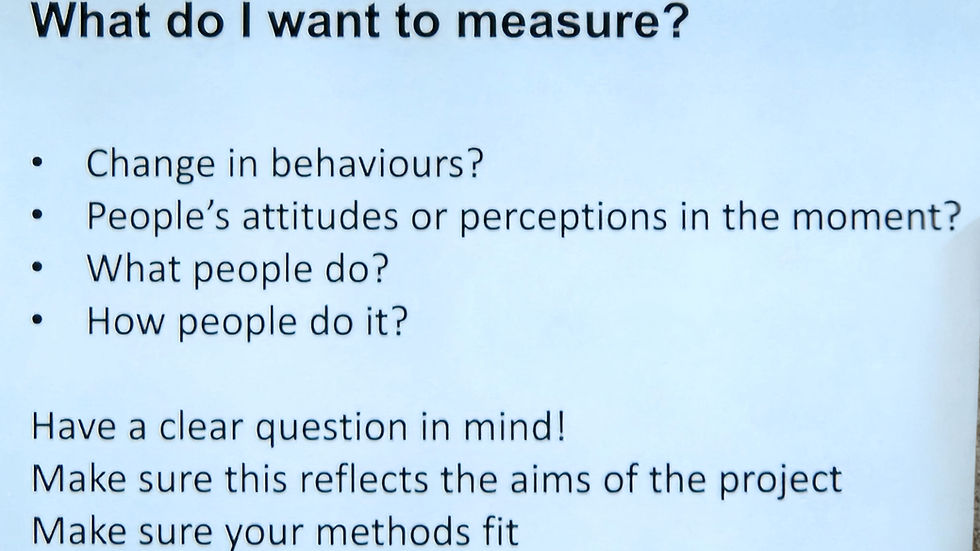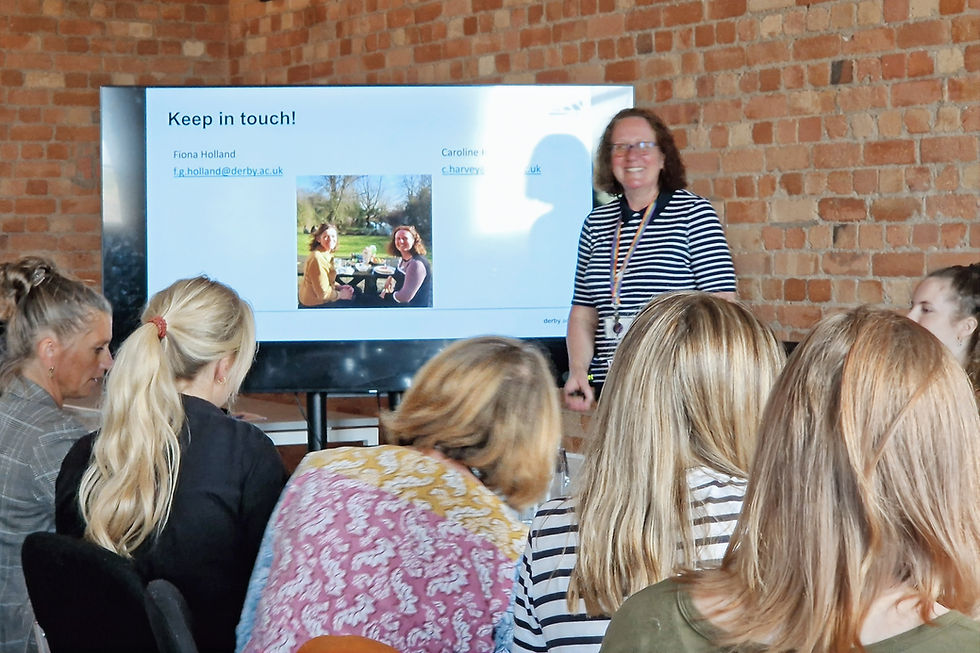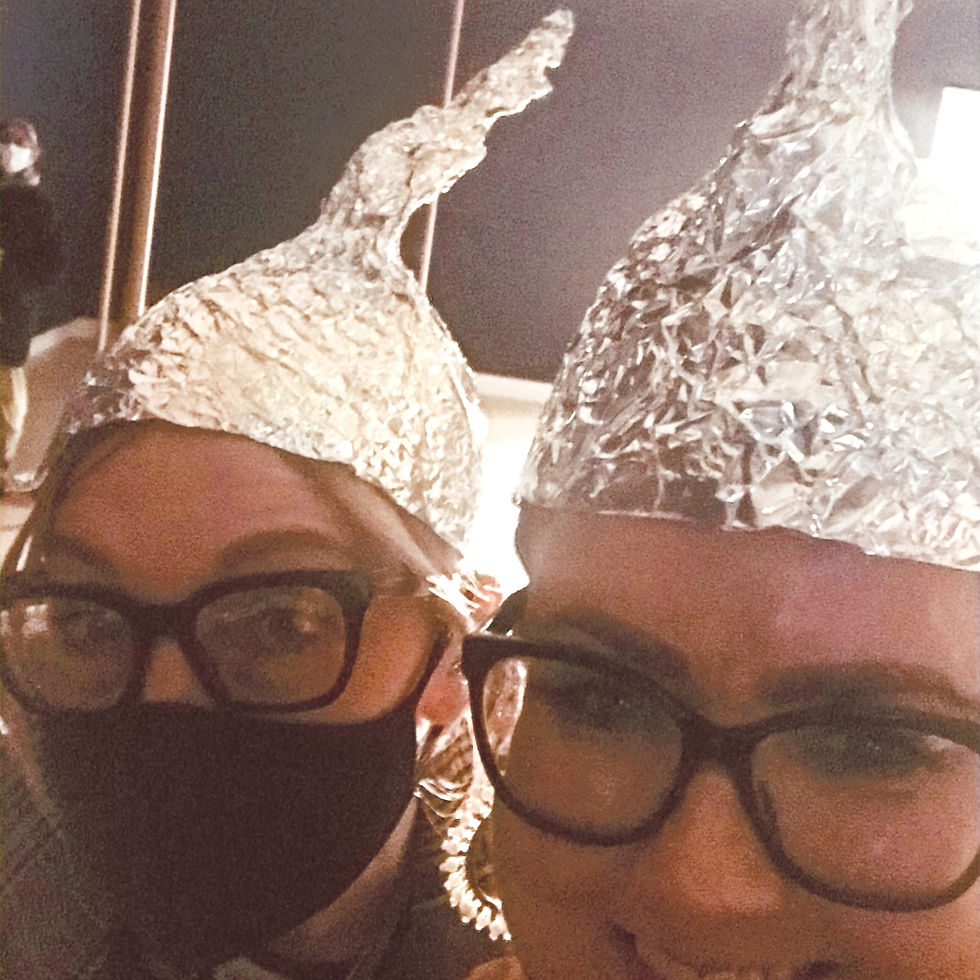How To Evaluate Community Projects As A Contemporary Community Textile Artist – 2025 Nature Connections | Derbyshire
- amanda haran

- Jul 23
- 10 min read
Updated: Sep 10

Creative Connections: Reflecting On The Nature Of Sector & Geographical Community
On the 16th and 17th of June, 2025, I found myself at the 'Nature Connections Conference' at Derby's Museum of Making, feeling that mix of excitement and the kind of anxiety that makes you question your life choices. My trusty sketch pad in hand (which had accompanied me to many an adventure as a contemporary community textile artist), I was hoping to catch some insights to provide clarity and direction on how to evaluate community projects (or at the very least score a free pen.)
As I scanned the room, I was surrounded by a vibrant mix of contemporary artists, community practitioners, researchers, policymakers, and the 'great and the good' from national institutions, mostly swathed in recognisable and impressive brands. Honestly, I felt like an introverted cat at a dog party as I hovered there, 'Billy No Mates', representing myself - so far out of my comfort zone. I ended up standing at the back, having missed the chance to snag a seat among the eager faces.
After kicking off my exceptionally snug heels (my feet having slightly swelled in the then 'heat dome', goodbye, fashion, hello comfort), I reflected on the reality of networking—a necessary evil in today's creative world.
In the style of Richard Branson, 'It's often not about what you know, but rather about who you know!'
As an empath, mingling can feel like stepping into a social minefield. I would add that this topic was not discussed during my degree, so when it loomed, it came as a shock. I often rely on the fundamentals from my counselling and psychotherapy training to help me navigate these complex social situations. This background allows me to connect authentically with others while staying relatively grounded amid the unpredictability of mingling as an empath.
Yet, despite my discomfort 'dad dancing' inside my head, the buzz of conversation, questions, and presentations was equally eccentric (as people were, on the whole, genuinely trying to 'push the envelope') but energising. I listened to people dive into passionate discussions about Nature, creativity, community, word use, law, film, and collaboration, and felt the warmth of those ideas soothe me. Maybe there was something to this after all. What if I could dismantle my introverted disposition and dad dancing distraction and discover the hidden gems of connection? I jumped two-footed. After all, who knows what insights might be waiting just beyond my comfort zone?
Learning About Evaluation For The Contemporary Community Textile Artist Derbyshire Methodology
My intentions for attending were straightforward: to enhance my understanding of how to evaluate creative community projects in line with current best practice models/trends and quietly mingle, still feeling relatively new to the Derbyshire scene.
Coming into this I'd tried to find a clean definition of my new job title, 'Creative Listener', connected to Make/Shift and the Neighbourhood Creative Agents programme, and had found the description conjoured by Richard Tripp; there had to be something more than that of the tech world and would align with my own holistic artistic response (but would keep his aspect of 'more fun.') I hoped the conference might address my dissatisfaction as the Arts Council didn't seem to have a clue either in respect of the programme I was part of.
With prior experience as a member of teams evaluating notable initiatives, such as the Turner Prize, I appreciate the significance of capturing the essence of artistic expression and its impact on those present.
Side Note: I've always been curious about why those who weren't present had chosen to stay away. Who's not in the room, and how can they be attracted?

In the past, I have taken the approach of using pictorial forms to communicate the outcomes of community engagement, allowing me to step outside the restraints that language and numbers might impose, thereby enhancing accessibility and fostering true understanding. My work on the Turner Prize was recognised as an intriguing practice by the Arts Council and taken away. I (try to) let others handle the details regarding statistics and graphs (though I am by no means decrying the importance of these either; I just think that numbers, words, and pictures can be happy bedfellows in telling the whole story.) Bizarrely, I've always felt more confident reflecting the intangibles. Despite these successes, I still find myself wrestling with questions about the actual impact of my evaluations, aside from capturing and sharing my instinctive and honest responses to the art and the people involved. What difference do they actually make? Would they still be destined to be buried along with the graphs and never see the light of day and/or further contemplation, irrespective of how 'pretty' they were? Is there a better way?

How To Evaluate Community Projects Beyond Numbers
While the conference was centred on Nature, my heart and ears were tuned toward something different: engagement with the community, irrespective of the creative vehicle used. I wanted to explore and learn how to sense these formed connections intrinsically, what emerged from them, and how best to capture and share them. Although I anticipated finding concrete answers, I instead discovered richer and more nuanced questions.
It is worth mentioning that my understanding is informed by Arts Council England's Evaluating Your Project – Project Grants guide, which provides a holistic framework that balances process, impact, and outcomes. It wouldn't be a complete post without nodding in the Arts Council's direction.

The sessions on 'Evaluating Nature-Based Interventions' led by Fiona Holland and Karoline Harvey from the School of Psychology at Derby University were not only informative; they also grasped the need to acknowledge our shared humanity.
A simple moment stood out to me when I went to grab my notebook as we had moved to an upper room to do a deeper dive: I found a stem of dried harvested flax that had made its way to the bottom of my bag (this is not uncommon as I find my flax in many strange places, check out the footwells of the cars I travel in!) As I ran my fingers over its brittle texture, I was reminded that some connections are powerful yet elusive and fragile. They live in the dark, silent spaces between words, in the moments before we focus on the ways we connect, and in the unspoken feelings that intertwine our experiences. We must be prepared to go and rummage for them, and be ever vigilant in case they pop up when and where we least expect.
What should we do with feelings that we can't quantify but still experience? Traditional evaluations often focus on attendance numbers, participant quotes and the like, but what truly matters to me are those intangible moments. The soothing blanket of warmth that fills a space after a heartfelt story is shared in a group, once sufficient trust has been built; the silent understanding exchanged between participants during a creative activity; and, one of my favourites, a man dancing in a Turner Prize installation because he felt free to do so. These experiences create an unspoken bond that lingers long after the moment has passed.

These magical instances, which I witness as a contemporary community textile artist in Derbyshire and beyond, are the threads that start connection. They remind us that the value of authenticity and humanity in our work often surpasses the significance of data.
Reflections from a Contemporary Community Textile Artist: Acknowledging Community Reality
Whilst I tried to hone in on and delve deeper into the intangibles of the conference, I need to acknowledge my introduction to the Asset-Based Community Development (ABCD) approach. Although 'formal' in my book, I love how it underscores the importance of recognising what communities already possess rather than focusing solely on their deficits. This philosophy strongly aligns with my practice, emphasising that beauty and empowerment thrive when we cultivate existing strengths and honour shared narratives. By focusing on community assets, facilitators and projects can foster a sense of agency among community members, enabling them to identify their own resources, capacities, and responses, and through diffusion dollop in a sort of gelatinous legacy that may continue to grow organically in the community petri dish long after the intervention. This is the central nub of the Creative Agents Programme.
While the ABCD approach has its strengths, it fails to fully resonate with my desire to hold the intrinsic in my palm and see as much of a holistic picture as possible. One limitation is that it can inadvertently overlook the complexities and nuances of community challenges. Acknowledging strengths is essential, but it is equally important to address the systemic issues that contribute to community struggles. By concentrating solely on assets, we risk oversimplifying the intricate realities that many communities face, potentially glossing over underlying deficits that require attention or, at the very least, should receive a nod of acknowledgement. If we ignore the situation, we may fail to understand why a project hasn't met its objectives, which is an essential part of my learning, evaluation and development.
The ABCD approach, while empowering, doesn't adequately capture the voices of all community members. Some individuals may feel marginalised or underrepresented within the narrative, creating a disconnect between the community's celebrated strengths and the lived experiences of its members. (I go back to my earlier reference to who is not in the room and why.) To truly honour the rich tapestry of community life, it's essential to integrate a more holistic view that encompasses both assets and challenges.
In my practice, I strive for a balanced approach that acknowledges the strengths of the community while also creating space to know its challenges. I recognise that achieving this is hard (and can be impossible) and requires healthy reserves of time, energy, and empathy.
This dual perspective helps to ensure that my collaborative creative work is not only uplifting but also grounded in the realities that community members face. By doing so, I hope to create more inclusive and equitable projects that genuinely reflect the diverse voices and experiences within that community and capture the intrinsic data that informs my work.
I enjoyed and resonated with Rhys Furlong's research on the experiences of low-income residents involved in community gardening. Their conversations about flow, safety, and belonging reflect the subtle yet significant transformations I observe in my own work—those small changes that often go unnoticed in traditional data analysis.
Fully Acknowledging & Celebrating The Role Of The Second 'Nut'
During the conference, it was suggested I watch the YouTube video 'How To Start A Movement,' by Derek Sivers, which I duly did.
I was struck by how the metaphor of the 'first' and 'second' 'nuts' perfectly captures the dynamics at play within the Make/Shift programme that I am set to evaluate.
In this context, the 'first nut' refers to the individual who dares to stand alone and initiate change, acting as the catalyst. The 'lone nut' is therefore the initial action or idea that starts a movement, i.e. Make/Shift. The 'second nut' then represents the initial follower, who becomes a quasi-leader by choosing to join the movement first, exemplifying and demonstrating how to effectively follow, i.e. the creative agent. In the case of Make/Shift, the creative agent demonstrates how to effect change and encourages others to do the same in their community. The ripple (hopefully) continues, just as in the TED talk. This metaphor has its limitations, I must admit (but it is fun), as the creative agent uses listening, reflecting, and walking alongside community members to tease out their issues and solutions, rather than just wildly dancing, but you get my drift.
The second 'nut' or creative agent requires tremendous courage to support and amplify a movement and should be wholly applauded. They add the critical momentum and energy. This idea highlights the importance of both initiating action and embracing the vulnerability required to foster community engagement and inspire others to join in.
My Role As An Evaluator: Exploring Emotional Impact Through Creative Listening

As I engage with the Make/Shift programme, my focus is on evaluating the experiences of the creative agents and the impact of their work within the community in a holistic and human sense. The creative agents are individuals empowered to take innovative and integrated action with and within their communities. My role is to understand and document the effects of their work (primarily on them, I think, as they will be the ones that I can see, feel, and sense, which is my preferred evaluation method.)
I am not going to collect data conventionally; instead, I aim to immerse myself in the emotions that connect the people and the programme, noticing the subtle shifts that often go unnoticed. At the conference, a speaker remarked, 'Connection isn't always in words; sometimes it's simply a change in how we stand.' This sentiment resonates deeply with the holistic approach I take in my evaluation execution and textile work.
Through growing and processing of flax, and hand stitching in my practice, I invite others to reconnect with the land, themselves and one another. For me, evaluation isn't segregated from creation; it is inherently part of the artistic journey. Like nurturing flax through its natural seasons, my evaluation unfolds deliberately, allowing space for reflection, shared experiences, and the emergence of new meanings from our collective creativity.
Conclusion: How Do You Evaluate Community Projects?
As I step into my role evaluating the Creative Agents Programme at Make/Shift, I plan to avoid showing up with a clipboard. Instead, I've got a heart full of curiosity and excitement, ready to uncover the beauty that's often hiding in plain sight, and scribble these 'noticings' into my trusty sketch pad that accompanied me to the conference.
Listening becomes a creative act for me—it's an opportunity to truly witness and amplify voices that might often be overlooked. The conference gave me a little more courage to continue developing my creative evaluation style, not unlike piecing together a beautiful quilt of emotions and moments.
As the event comes to a close, I have to admit that mingling can be quite a workout! After two days filled with small talk and laughter, I feel like I need a nap more than a packed social calendar. Who knew that navigating conversations could be as exhausting as running a marathon? Honestly, I believe I might have burned a few calories dodging awkward silences and trying to remember all the names I heard. I anticipate that the active listening and observation required during the Make/Shift evaluation will be equally draining.
At the end of the day, while it's important to understand emotional and psychological dynamics, what really matters is the connections we make. Sometimes all you need is a good brew, a comfy chair, and a willingness to just be present. Here's to surviving this social marathon and celebrating the stories we share along the way.
Now, if only I could figure out how to nap standing up.












